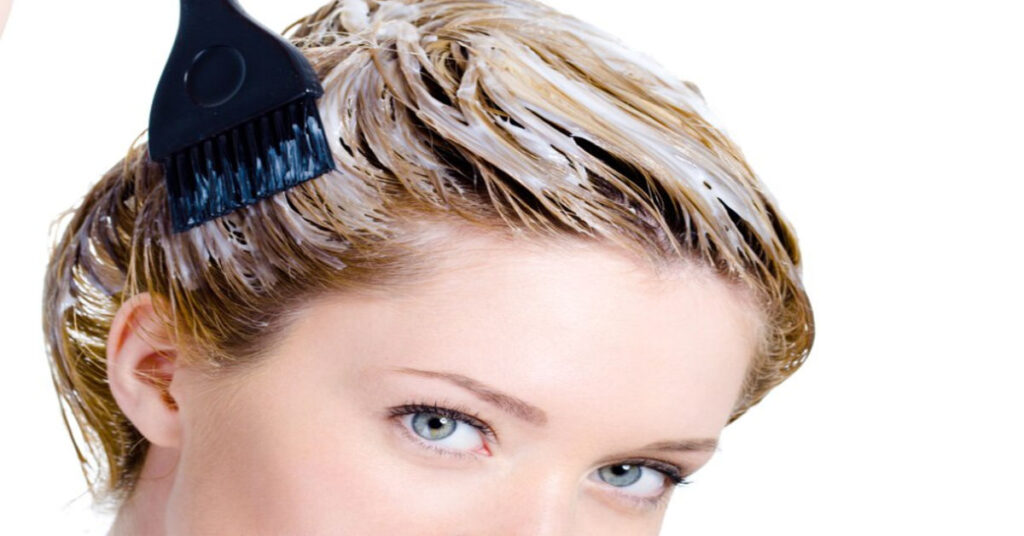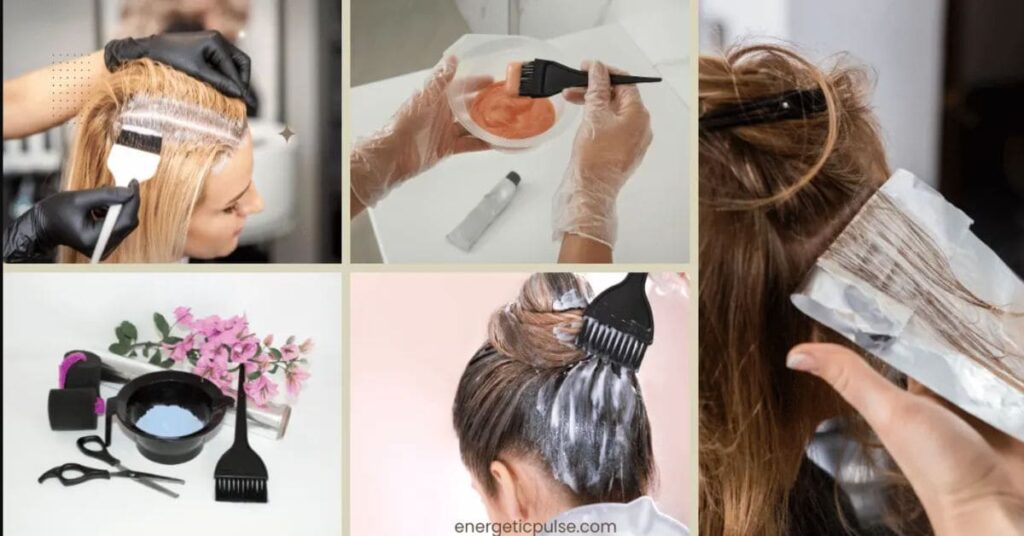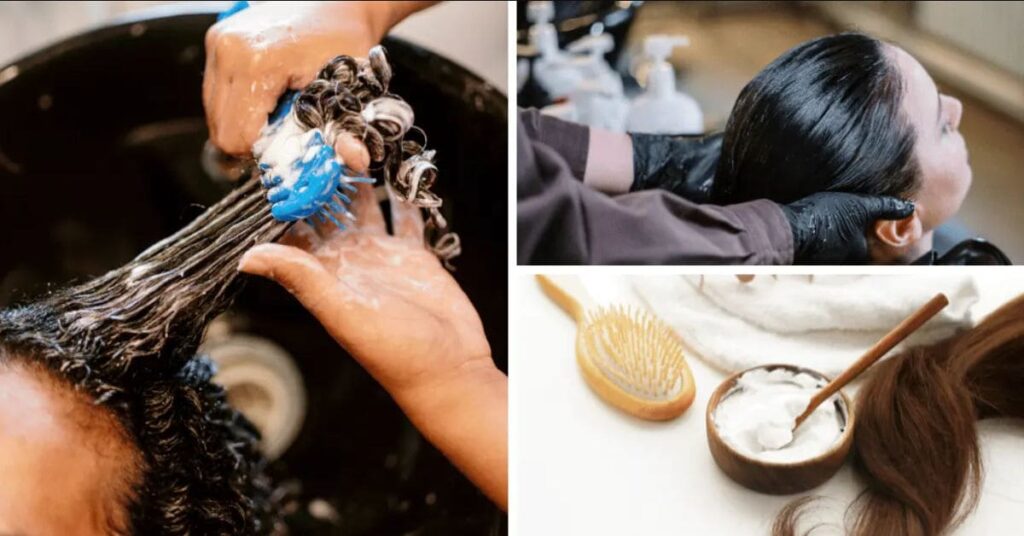Yes, hair dye can potentially harm your hair, depending on various factors such as the type of dye used, the condition of your hair, and how it’s applied. Here are some potential ways hair dye can harm your hair:
Chemical Damage:
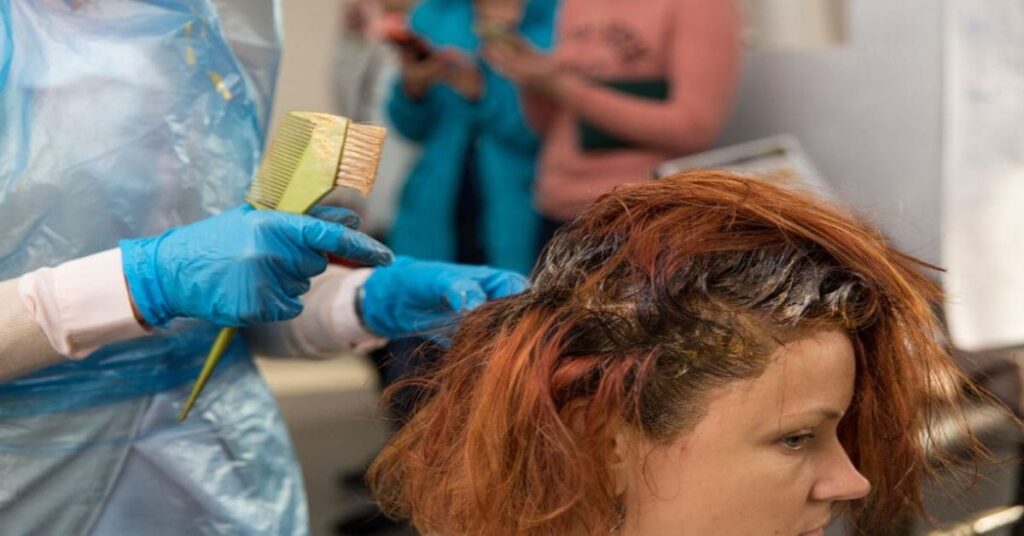
Chemical damage from hair dye occurs primarily due to the harsh chemicals present in many hair coloring products. It is important to understand how these chemicals can harm your hair.
1. Ammonia: Ammonia is commonly found in permanent hair dyes and serves to open up the hair cuticle so that the dye molecules can penetrate the hair shaft. However, ammonia can be highly drying and damaging to the hair cuticle, stripping away its natural oils and proteins. This can lead to weakened hair shafts, making them prone to breakage, split ends, and overall dullness.
2. Hydrogen Peroxide: Hydrogen peroxide is another key ingredient in permanent hair dyes. It’s used to bleach the natural pigment in the hair before depositing the new color. However, hydrogen peroxide can be quite harsh, especially at higher concentrations, and can lead to significant damage to the hair’s structure. It can cause the outer layer of the hair, known as the cuticle, to become rough and porous, resulting in loss of moisture, increased frizz, and a weakened hair shaft.
3. P-Phenylenediamine (PPD): PPD is a common chemical found in many permanent hair dyes and is responsible for creating the actual color change in the hair. While PPD is effective at producing long-lasting color, it can also be highly irritating to the scalp and skin. Allergic reactions to PPD can range from mild itching and redness to more severe symptoms such as blistering and swelling.
4. Resorcinol: Resorcinol is another chemical compound found in hair dyes that helps to provide color permanence. However, like PPD, it can also cause skin irritation and allergic reactions in some individuals. Prolonged exposure to resorcinol can lead to dryness, irritation, and inflammation of the scalp.
5. Permanent Alterations: Beyond immediate damage, frequent use of permanent hair dyes can lead to long-term alterations in the hair’s structure and texture. Continuous exposure to harsh chemicals can weaken the hair fibers, leading to a loss of elasticity and resilience. This can result in hair that feels brittle, looks dull, and is more prone to breakage and split ends over time.
To minimize chemical damage from hair dye, consider using gentler alternatives such as semi-permanent or ammonia-free dyes, and ensure proper hair care practices such as deep conditioning treatments and avoiding excessive heat styling.
Allergic Reactions
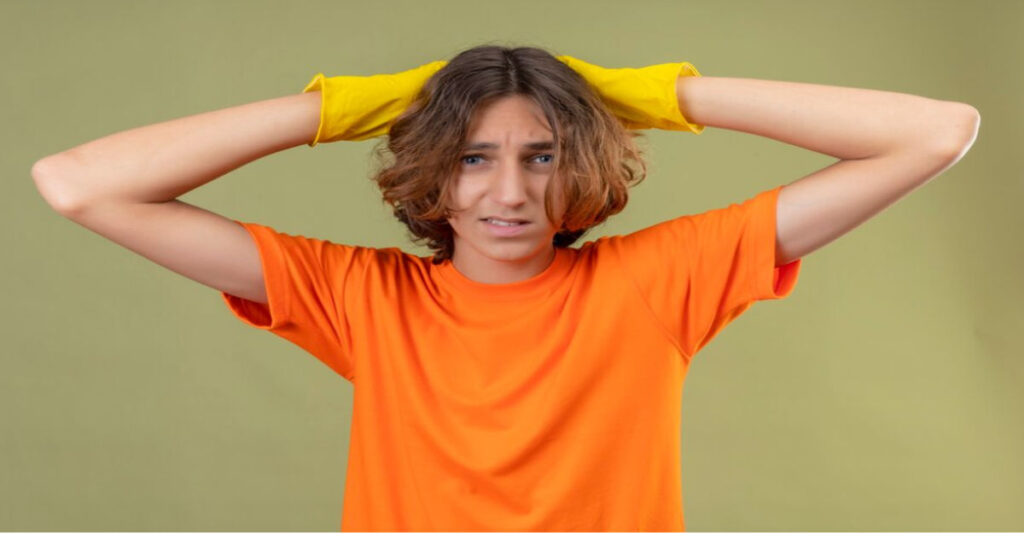
Allergic reactions to hair dye can range from mild irritation to severe symptoms, and they occur when the body’s immune system reacts to the chemicals present in the dye. Here’s a more detailed look at allergic reactions to hair dye:
1. Contact Dermatitis: Contact dermatitis is the most common allergic reaction to hair dye. It typically manifests as redness, itching, burning, or swelling of the scalp, face, neck, or ears where the dye comes into contact with the skin. This reaction occurs when the immune system recognizes the dye chemicals as foreign substances and launches an inflammatory response.
2. Sensitization: With repeated exposure to certain chemicals in hair dye, some individuals may become sensitized, meaning their immune system becomes increasingly reactive to those substances over time. This can lead to more severe allergic reactions upon subsequent exposure, even to small amounts of the allergen.
3. Anaphylaxis: In rare cases, severe allergic reactions to hair dye can lead to anaphylaxis, a life-threatening allergic reaction characterized by symptoms such as difficulty breathing, swelling of the face and throat, rapid heartbeat, and loss of consciousness. Anaphylaxis requires immediate medical attention and may necessitate the use of epinephrine (EpiPen) to reverse the symptoms.
4. Chemical Sensitivity: Some individuals may experience chemical sensitivity rather than a true allergic reaction to hair dye. Chemical sensitivity can cause symptoms similar to allergic reactions, such as itching, burning, and irritation, but it does not involve the immune system’s response. Instead, it may be due to the irritant effects of certain chemicals in the dye.
5. Cross-Reactivity: People who are allergic to certain substances, such as paraphenylenediamine (PPD) or related compounds found in hair dye, may also experience allergic reactions to other products containing similar chemicals, such as certain types of black clothing dye, temporary tattoos, or certain types of rubber.
To minimize the risk of allergic reactions to hair dye:
- Always perform a patch test before using any new hair dye, even if you have used similar products in the past.
- Follow the instructions provided by the manufacturer for conducting a patch test, typically applying a small amount of dye to a small area of skin and monitoring for any adverse reactions for 24 to 48 hours.
- Consider using alternative hair dye formulations that are free of common allergens such as ammonia, PPD, and resorcinol.
- If you have a history of allergic reactions to hair dye or other products, consult a dermatologist or allergist for personalized recommendations and allergy testing.
- If you experience any signs of an allergic reaction, such as itching, redness, swelling, or difficulty breathing, discontinue use of the product immediately and seek medical attention if symptoms worsen or persist
Overprocessing
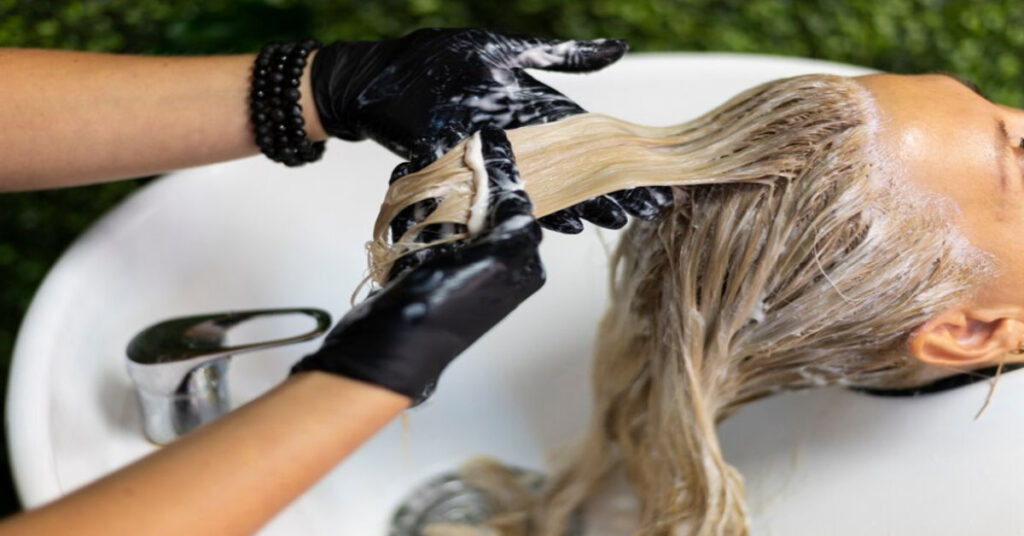
Overprocessing of hair occurs when it undergoes excessive chemical treatments or mechanical stress, leading to damage and weakening of the hair fibers. Overprocessing can occur due to various factors, including frequent coloring, bleaching, perming, straightening, or heat styling. Here’s a more detailed look at overprocessing and its effects on hair:
1. Coloring: Overprocessing can occur when hair is subjected to frequent coloring with permanent hair dyes. These dyes contain harsh chemicals such as ammonia and hydrogen peroxide, which can strip away the natural oils and proteins from the hair, leading to dryness, brittleness, and breakage. Additionally, repeated coloring can cause the hair cuticle to become rough and porous, making it more susceptible to damage.
2. Bleaching: Bleaching is a chemical process used to lighten the hair by stripping away its natural pigment. However, excessive bleaching can lead to overprocessing, as the bleach can weaken the hair fibers and cause them to become brittle and prone to breakage. Bleaching also opens up the hair cuticle, making it more vulnerable to damage from other chemical treatments or environmental factors.
3. Perming: Perming involves using chemicals to break and reform the bonds in the hair to create curls or waves. Overprocessing can occur if the perm solution is left on for too long or if the hair is subjected to multiple perm treatments in a short period of time. This can result in overly dry, frizzy, and damaged hair, as well as breakage and split ends.
4. Straightening: Chemical straightening treatments, such as relaxers or keratin treatments, can also lead to overprocessing if not performed correctly or if done too frequently. These treatments alter the structure of the hair, making it more susceptible to damage from heat styling and other chemical processes. Over time, the hair may become weak, limp, and prone to breakage.
5. Heat Styling: Excessive use of heat styling tools such as flat irons, curling irons, and blow dryers can also contribute to overprocessing of hair. High temperatures can damage the hair cuticle, leading to dryness, frizz, and breakage. It’s essential to use heat-protectant products and avoid using heat styling tools on high settings to minimize damage to the hair.
To prevent overprocessing and minimize damage to the hair:
- Limit the frequency of chemical treatments such as coloring, bleaching, perming, and straightening.
- Choose gentler hair care products and formulations, such as ammonia-free hair dyes or sulfate-free shampoos.
- Deep condition the hair regularly to help restore moisture and nourishment.
- Avoid excessive heat styling and use heat protectant products when using heat styling tools.
- Trim the hair regularly to remove split ends and prevent further damage from spreading along the hair shaft.
- Consult with a professional hairstylist or trichologist for personalized recommendations and treatment options for damaged hair.
Color Changes:
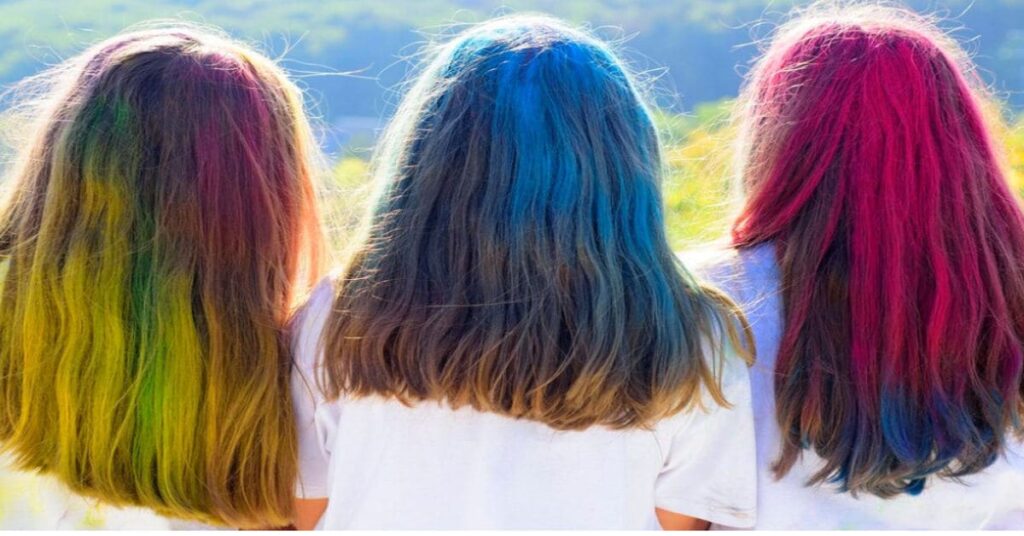
Color changes from hair dye can occur in various ways, both intended and unintended. Here’s a detailed look at the different aspects of color changes that can result from using hair dye:
1. Intended Color Change: Hair dye is primarily used to achieve a desired color change. Whether you’re covering gray hair, enhancing your natural color, or opting for a bold new shade, hair dye can effectively alter the color of your hair. Different types of dyes, such as permanent, semi-permanent, and temporary, offer varying levels of color intensity and longevity.
2. Uneven Color Distribution: One common issue with hair dyeing is achieving an uneven color distribution. This can occur due to various factors, such as uneven application of the dye, differences in hair porosity, or variations in the starting color of the hair. Areas that are more porous may absorb more dye, resulting in a darker or more vibrant color, while less porous areas may appear lighter or less saturated.
3. Brassy Tones: When lightening hair or using certain hair dye shades, especially blonde or light brown tones, unwanted brassy or orange tones can develop. This often happens when the underlying pigment in the hair is not fully neutralized or when the dye fades over time. Brassy tones can be corrected or prevented by using toning products specifically designed to counteract unwanted warmth.
4. Unintended Hue: Sometimes, hair dye can produce an unintended hue or undertone. For example, a hair dye-labeled “ash blonde” may turn out more greenish or grayish than expected due to the interaction between the dye pigments and the underlying tones in the hair. Understanding color theory and selecting the appropriate dye shades can help minimize the risk of unintended hue shifts.
5. Color Fading: Over time, hair dye can fade due to factors such as washing, exposure to sunlight, heat styling, and environmental pollutants. This can result in a loss of vibrancy and intensity, leading to a dull or washed-out appearance. Using color-safe shampoos and conditioners, minimizing heat styling, and protecting the hair from UV damage can help prolong the life of your hair color.
6. Color Overlap: If you frequently dye your hair or use different types of hair dye, color overlap can occur, leading to buildup and alteration of the hair color. This can result in uneven or patchy color, especially at the roots or in areas that receive multiple dye applications.
To achieve the desired color changes and minimize unintended effects:
- Follow the instructions provided with the hair dye carefully, including pre-color treatments and application techniques.
- Conduct strand tests and patch tests before applying the dye to the entire head to assess color compatibility and potential allergic reactions.
- Seek professional assistance from a hairstylist or colorist for complex coloring techniques or if you’re unsure about achieving your desired color at home.
- Use color-safe hair care products formulated to protect and maintain your hair color, and avoid excessive washing or heat styling.
Dryness and Frizz
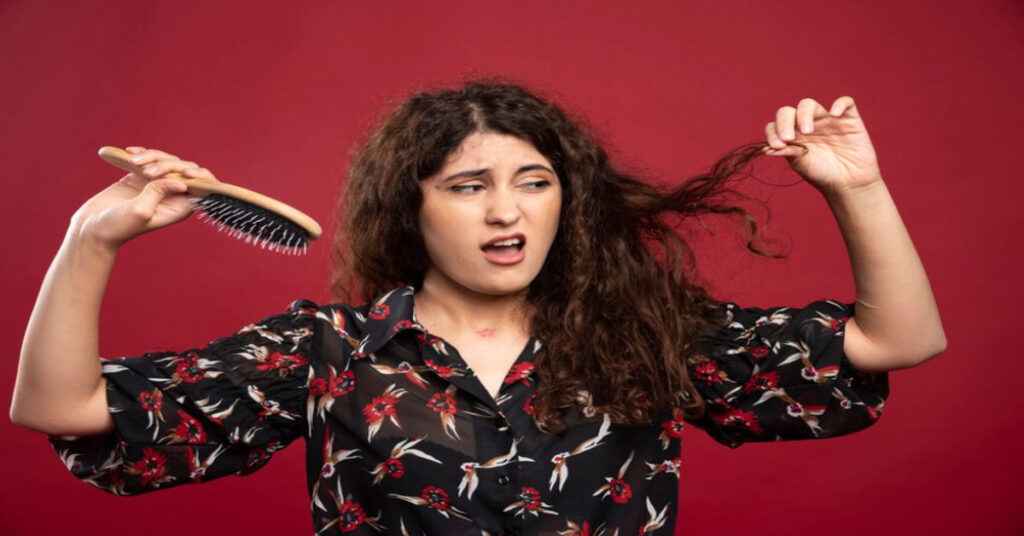
Dryness and frizz are common concerns associated with hair dyeing, especially when harsh chemicals are involved. Here’s a more detailed look at how hair dyeing can contribute to dryness and frizz, as well as tips for managing these issues:
1. Chemical Damage: Many hair dyes contain ingredients like ammonia and hydrogen peroxide, which can strip away the natural oils and proteins from the hair. This chemical damage disrupts the hair’s moisture balance, leading to dryness and dehydration. As a result, the hair becomes more prone to frizz, as it seeks moisture from the surrounding environment to compensate for the loss.
2. Hair Cuticle Damage: Hair dyeing often involves opening the hair cuticle to allow the dye molecules to penetrate the hair shaft. This process can cause the outer layer of the hair, known as the cuticle, to become rough and raised, making it more susceptible to damage and moisture loss. When the cuticle is damaged, the hair loses its ability to retain moisture effectively, leading to dryness and frizz.
3. pH Imbalance: The alkaline nature of many hair dyes can disrupt the natural pH balance of the hair and scalp. This pH imbalance can weaken the hair’s structure and impair its ability to retain moisture, resulting in dry, frizzy hair. Using acidic rinses or treatments after dyeing can help restore the hair’s pH balance and seal the cuticle, reducing frizz and enhancing shine.
4. Lack of Conditioning: After dyeing, the hair may require extra conditioning to replenish lost moisture and restore softness and manageability. However, some people may neglect proper conditioning or use products that are not suitable for color-treated hair, exacerbating dryness and frizz. Deep conditioning treatments, leave-in conditioners, and hair masks specifically formulated for color-treated hair can help nourish and hydrate the hair, reducing frizz and improving its overall health and appearance.
5. Environmental Factors: Environmental factors such as humidity, heat, and exposure to UV radiation can exacerbate dryness and frizz in color-treated hair. Humidity causes the hair to absorb moisture from the air, leading to swelling of the hair shaft and increased frizz. Heat styling tools and prolonged sun exposure can further dry out the hair and compromise its moisture balance. Using heat-protectant products and wearing protective hairstyles can help minimize damage from environmental factors.
To manage dryness and frizz associated with hair dyeing:
- Choose gentle, moisturizing hair dye formulations that are free of harsh chemicals like ammonia and hydrogen peroxide.
- Deep condition the hair regularly with hydrating hair masks or treatments to replenish moisture and improve manageability.
- Use sulfate-free, color-safe shampoos and conditioners to gently cleanse and hydrate the hair without stripping away color or natural oils.
- Avoid overwashing the hair, as excessive shampooing can strip away moisture and contribute to dryness and frizz.
- Minimize heat styling and use heat protectant products when using hot tools to prevent further damage to the hair.
- Protect the hair from environmental factors by wearing hats or scarves in harsh weather conditions and using UV-protectant hair products.
- Consider incorporating natural oils, such as argan oil or coconut oil, into your hair care routine to nourish and moisturize the hair.
